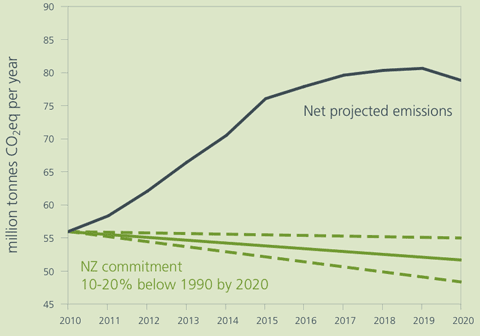 Sea level rise of up to 40cm around New Zealand by the middle of this century is already locked in and will cause significant problems for coastal communities and infrastructure, according to a new report just released by Dr Jan Wright, the Parliamentary Commissioner for the Environment. The report — Changing Climate and Rising Seas: Understanding the Science [pdf] — provides an overview of why sea levels are currently rising and why they are expected to continue rising over the rest of this century and beyond. A follow-up report due next year will “show in some detail which areas of the coastline around the country are most vulnerable to sea level rise and assess the risk to infrastructure in those areas”.
Sea level rise of up to 40cm around New Zealand by the middle of this century is already locked in and will cause significant problems for coastal communities and infrastructure, according to a new report just released by Dr Jan Wright, the Parliamentary Commissioner for the Environment. The report — Changing Climate and Rising Seas: Understanding the Science [pdf] — provides an overview of why sea levels are currently rising and why they are expected to continue rising over the rest of this century and beyond. A follow-up report due next year will “show in some detail which areas of the coastline around the country are most vulnerable to sea level rise and assess the risk to infrastructure in those areas”.
Introducing the report, Dr Wright said that the scientific evidence is now irrefutable. “The climate is changing and causing the sea to rise”.
“A rise of 30 cm may not sound much, but its impact will be very costly for many landowners. Damaging coastal floods will become increasingly frequent. The insurance industry is becoming aware of, and responding to, the increased flooding risk. Some councils and communities have already started to face hard questions.”
Commenting on the report for the Science Media Centre, Associate Professor Nancy Bertler of the Joint Antarctic Research Institute, Victoria University of Wellington/GNS Science, said:
The report provides an excellent summary on the current knowledge of past and future sea level rise including the main drivers and the regional patterns. Dr. Wright highlights the concern of the scientific community on the possibility of substantial and abrupt future contributions from the West Antarctic ice sheet.
Additional important considerations are that: worldwide over 200 million people live within one metre of sea level. The last time atmospheric carbon dioxide concentration was at 400 ppm (3-5 million years ago) the associated global temperatures caused the Greenland and West Antarctic ice sheets to catastrophically collapse – raising global sea level by around ten to twenty metres.
The rate at which sea level will rise has important implications on our ability to adapt. New research suggests that sea level could rise as quickly as 4 metres per 100 years (or 1 metre per 25 years). Assuming even a modest global sea level increase of 50 cm by 2100 (IPCC scenario RCP 4.5), the frequency of coastal inundation in New Zealand is predicted to increase by a multiplier of 1000 times.
Under such a scenario, an annual event becomes a daily event, a ‘100 year’ event occurs several times per year. As an approximation: every 0.1m rise triples the frequency of inundation events.
Dr Wright focusses on the near term implications for New Zealand, a sensible choice given the tendency to dismiss sea level rise as a problem for the distant future, but in my view she misses an opportunity to spell out the strong relationship between atmospheric CO2 levels and equilibrium sea level. The last time CO2 stood at 400 ppm, global sea level was about 20m higher than today. That’s where we’re heading, unless we can get greenhouse gas levels down, and it has very important implications for emissions policy. But I’m nit-picking…
Changing Climate and Rising Seas is a very readable introduction to the science of sea level rise, and gives a very clear picture of the state of current knowledge. It’s a welcome addition to what passes for national discourse on the inevitability of climate change and the necessity of adapting to what it brings. Next year’s report on regional impacts will be even more important.

 Dr Jan Wright, New Zealand’s
Dr Jan Wright, New Zealand’s 